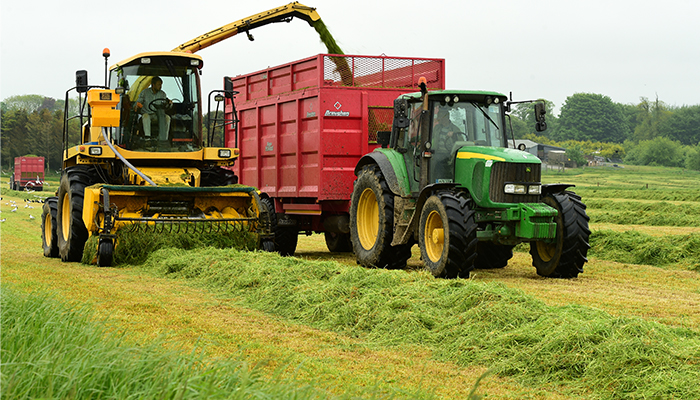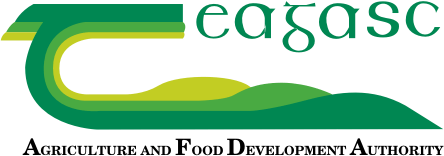08 July 2024
The cost of feedstuffs on beef farms

Visitors to BEEF2024 heard of the ‘Grange Feed Costings Model’, which was used to determine the cost of commonly grown feed crops in March-April 2024. Feedstuffs included grazed grass – with and without white clover – grass and red clover silage, maize and fodder beet.
Assumptions applied for each feedstuff are outlined in Table 1. Slurry was applied to all crops, which lowered the requirements for inorganic (chemical) fertiliser. Based on market prices in April 2024, ‘protected’ urea (the inorganic nitrogen fertiliser source used) and 0-7-30 cost €520/tonne each, and rolled barley and beef finishing ration cost €270 and €350/tonne fresh weight, respectively.
Contracting costs (including VAT) were based on Farm Contractors Ireland reference figures; pit silage = €180/acre, mowing = €29/acre, tedding = €17/acre, baling = €9/bale, maize harvesting = €207/acre, beet harvesting = €175/acre.
It is acknowledged that these prices may change throughout 2024. Land charge was assumed to be €250/acre (€618/hectare), which is similar to that outlined in the SCSI/Teagasc Agricultural Land Market Review and Outlook Report. All figures include the cost of feeding out and processing.
Table 1: Assumptions and estimated costs (€) to produce feedstuffs in spring 2024
| Grazed grass | Grazed grass + clover | Zero-grazing grass all year1 | First + second cut pit silage2 | First + second cut bale silage2 | Three-cut red clover silage3 | Maize silage (open)3 | Fodder beet 4 | Purchased rolled barley @€270/t | Beef finishing ration @€350/t | |
|---|---|---|---|---|---|---|---|---|---|---|
| Assumptions used | ||||||||||
| Dry matter (DM) yield t/ha | 13 | 13 | 13 | 6 + 4 | 6 + 4 | 5.6 + 4.0 + 3.5 | 13 | 15 | – | – |
| Dry matter utilised (t/ha) | 10.4 | 10.4 | 10.4 | 7.7 | 8.5 | 10 | 11.1 | 12 | – | – |
| Dry matter (%) | 17.4 | 17.4 | 17.4 | 21.7 | 32.4 | 30 | 30 | 19 | – | – |
| UFL / kg DM | 1.03 | 1.02 | 1.03 | 0.82 | 0.82 | 0.82 | 0.82 | 1.12 | – | – |
| DM digestibility (%) | 82 | 81 | 82 | 73 | 73 | 73 | 73 | 86 | – | – |
| Inorganic nitrogen fertiliser (kg/ha)5 | 225 | 100 | 225 | 87 + 69 | 87 + 69 | – | – | 114 | – | – |
| Total nitrogen fertiliser (kg/ha) | 250 | 125 | 250 | 115 + 82 | 115 + 82 | 0 | 0 | 145 | – | – |
| Feed costs (April 2024) | ||||||||||
| Total cost/ha (incl. land charge) (€)6 | 1,221 | 1,079 | 2,572 | 2,133 | 2,522 | 2,720 | 3,044 | 3,728 | – | – |
| Total cost/ha (excl. land charge)(€) | 603 | 462 | 1,955 | 1,716 | 2,105 | 2,183 | 2,427 | 3,105 | – | – |
| Total cost/t DM grown (incl. land charge) (€)6 |
94 | 83 | 198 | 213 | 252 | 208 | 238 | 248 | – | – |
| Total cost/t DM grown (excl. land charge) (€) |
46 | 36 | 150 | 172 | 211 | 167 | 189 | 207 | – | – |
| Total cost/t DM utilised (incl. land charge) (€)6 |
117 | 104 | 247 | 276 | 296 | 274 | 273 | 308 | – | – |
| Total cost/t DM utilised (exc. land charge) (€) |
58 | 44 | 188 | 222 | 247 | 220 | 218 | 257 | – | – |
| Relative cost to grazed grass per energy utilised (UFL) including land charge6 |
1.0 | 0.9 | 2.1 | 2.9 | 3.2 | 2.9 | 3.0 | 2.4 | 2.5 | 3.5 |
| Relative cost to grazed grass per energy utilised (UFL) excluding land charge |
1.0 | 0.8 | 3.2 | 4.8 | 5.4 | 4.8 | 4.8 | 4.1 | 5.0 | 7.1 |
Assumptions: 1Zero-grazing as carried out by contractor does not include the cost of handling extra slurry vs. grazing. 2First-cut and second-cut silage were assumed to be harvested on 29 May and 17 July, respectively. 3Slurry + 0-7-30 fertiliser for the remainder of P and K requirements; does not include autumn grazing. Six-year persistence assumed. 4The extra cost of feed protein supplementation required for maize and fodder beet is not included. Beet washing and chopping is included. 5Remainder of nitrogen requirement was met with slurry (organic N) application. 6Land charge of €618/ha (€250/acre).
Grazed grass costs €94/tonne dry matter (t DM) grown (including land charge), which is the equivalent to 9.4c/kg DM grown or 11.7c/kg DM utilised, making it the cheapest feed resource, with white clover inclusion adding further reductions in cost (Table1).
The cost of zero-grazed grass is greater than grazed grass but cheaper than grass silage. Although three-cut red clover silage has a lower nitrogen fertiliser cost than two-cut grass silage, the addition of the third-cut and the lower lifespan of the red clover results in it having a similar cost to grass silage. Baled silage remains more expensive than pit silage. A more detailed breakdown of the estimated cost of baled silage is outlined in Table 2.
Table 2: Calculated cost to produce a round bale of grass silage in 2024
| Column 1 | Cost per bale (€) | Cost per tonne dry matter grown (€) | Contribution to total cost (excl. land charge) |
|---|---|---|---|
| Fertiliser (including spreading)1 | 9.60 | 48 | 23% |
| Harvesting | 26.77 | 134 | 64% |
| Other (feeding, herbicides etc.) | 3.25 | 13 | 7% |
| Fixed costs (reseeding/facilities) | 2.51 | 211 | 6% |
| Total excluding land charge | 42.12 | 252 | – |
| Total including land charge | 50.46 | – |
Assumptions: 12500 and 2000 gallons/acre of slurry was applied for first-cut and second-cut silage, respectively, and the remainder of nutrient requirements was supplied via inorganic nitrogen fertiliser.
Maize silage remains more expensive than fodder beet and slightly more expensive than grass silage (pit). This analysis assumed maize was ‘open’. Covering maize with plastic (with a corresponding increase in yield of 2.0 t DM/ha) results in the cost increasing by 4% from €238/t DM grown to €248/t DM grown. Fodder beet has somewhat lower production costs compared to grass silage when expressed per unit net energy utilised basis. It should be noted that compared to grass crops, maize silage and fodder beet have a greater requirement for supplementary protein and minerals, which were not included in this analysis.
Purchased concentrates such as rolled barley and beef finishing ration remain an expensive feed source, and especially compared to grazed grass. The competitiveness of concentrate feeds against grass silage per unit of net energy utilised will primarily depend on ration price and whether a land charge is considered or not.
Feed costings are provided with and without (‘cash cost’) a land charge. In theory, a land charge should be included to account for the opportunity cost of land.
The figures in Table 1 can be used to calculate the costs of feeding an animal. For example if a steer is consuming 8.5 kg DM/day whilst grazing, it costs €0.99/day to feed him, including land charge (i.e. 8.5 kg DM × 11.7 c/kg DM utilised).
This article was adapted for use on Teagasc Daily from the paper titled: ‘Beef production from grass forage-based system’ authored by Edward O’Riordan, Mark McGee, Catherine Egan, Paul Crosson and Peter Doyle, which first appeared in the BEEF2024 Open Day book.
For more insights from BEEF2024, including the full open day book and boards, click here.
Also read: Quality, traceability and trust – Supermac’s reasons for buying Irish beef
Also read: ‘Top 3 MACC measures’ must be prioritised in beef’s emissions reduction journey
Also read: Labour on beef farms
Also read: Lifetime clover systems study underway at Derrypatrick
